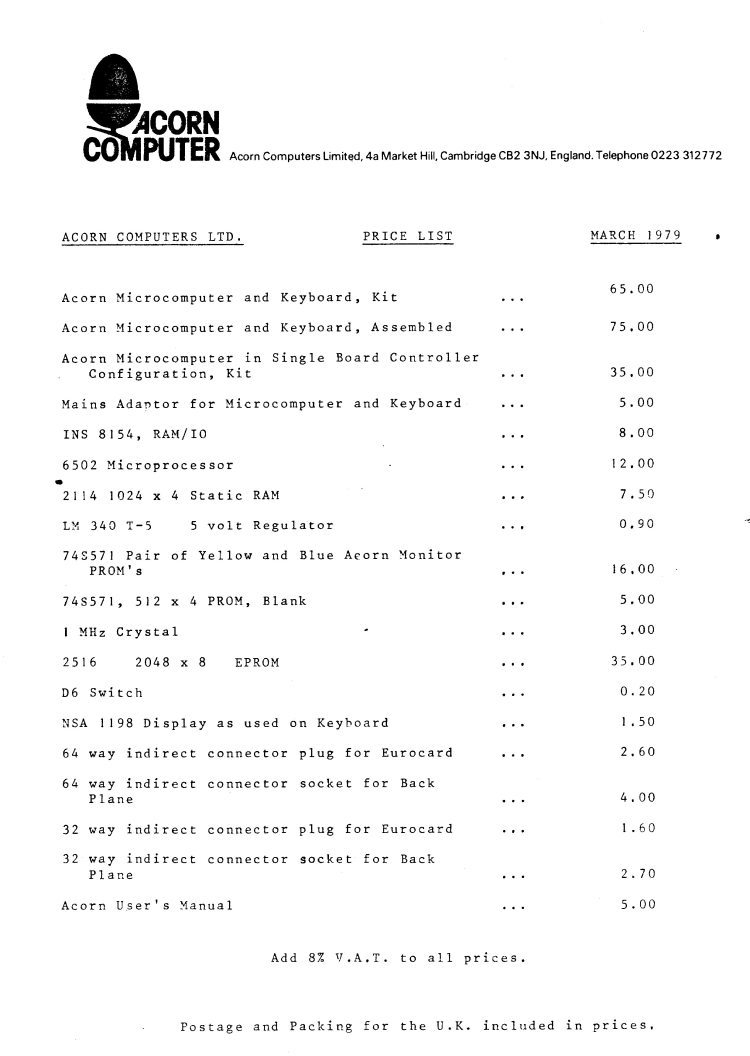|
Acorn Computers
Acorn Computers Ltd. was a British computer company established in Cambridge, England, in 1978. The company produced a number of computers which were especially popular in the United Kingdom, UK, including the Acorn Electron and the Acorn Archimedes. Acorn's computer dominated the UK educational computer market during the 1980s. Though the company was acquired and largely dismantled in early 1999, with various activities being dispersed amongst new and established companies, its legacy includes the development of reduced instruction set computing (RISC) personal computers. One of its operating systems, , continues to be developed by RISC OS Open. Some activities established by Acorn lived on: technology developed by Arm (company), Arm, created by Acorn as a joint venture with Apple, Inc., Apple and VLSI Technology, VLSI in 1990, is dominant in the mobile phone and personal digital assistant (PDA) microprocessor market. Acorn is sometimes referred to as the "British Apple" and ... [...More Info...] [...Related Items...] OR: [Wikipedia] [Google] [Baidu] |
Hermann Hauser
Hermann Maria Hauser, KBE, FRS, FREng, FInstP, CPhys (born 1948) is an Austrian-born entrepreneur, venture capitalist and inventor who is primarily associated with the Cambridge technology community in England. Education and early life When Hauser was 16 he went to the United Kingdom to learn English at a language school in Cambridge. After a master's degree in Physics from Vienna University, he returned to King's College, Cambridge to do a PhD in Physics at the Cavendish Laboratory. Career Hauser is probably best known for his part in setting up Acorn Computers with Chris Curry in 1978. When Olivetti took control of Acorn in 1985 he became vice-president for research at Olivetti, in charge of laboratories in the US and Europe. In 1986, Hauser co-founded the Olivetti Research Laboratory (ORL) in Cambridge with Andy Hopper, who became the laboratory's director. Hauser's role in Acorn was portrayed by Edward Baker-Duly in the BBC drama ''Micro Men''. In 1988, Hauser left ... [...More Info...] [...Related Items...] OR: [Wikipedia] [Google] [Baidu] |
Acorn Network Computer
The Acorn Network Computer was a network computer (a type of thin client) designed and manufactured by Acorn Computers Ltd. It was the implementation of the Network Computer Reference Profile that Oracle Corporation commissioned Acorn to specify for network computers (for more detail on the history, see Acorn's Network Computer). Sophie Wilson of Acorn led the effort. It was launched in August 1996. The NCOS operating system used in this first implementation was based on RISC OS and ran on ARM hardware. Manufacturing obligations were achieved through a contract with Fujitsu subsidiary D2D. In 1997, Acorn offered its designs at no cost to licensees of . Hardware models Original model The NetStation was available in two versions, one with a modem for home use via a television, and a version with an Ethernet card for use in businesses and schools with VGA monitors and an on-site BSD Unix fileserver based on RiscBSD, an early ARM port of NetBSD. Both versions were upgradable ... [...More Info...] [...Related Items...] OR: [Wikipedia] [Google] [Baidu] |
Fairchild Semiconductor
Fairchild Semiconductor International, Inc. was an American semiconductor company based in San Jose, California. Founded in 1957 as a division of Fairchild Camera and Instrument, it became a pioneer in the manufacturing of transistors and of integrated circuits. Schlumberger bought the firm in 1979 and sold it to National Semiconductor in 1987; Fairchild was corporate spin-off, spun off as an independent company again in 1997. In September 2016, Fairchild was acquired by ON Semiconductor. The company had locations in the United States at San Jose, California; San Rafael, California; South Portland, Maine; West Jordan, Utah; and Mountaintop, Pennsylvania. Outside the US it operated locations in Australia; Singapore; Bucheon, Bucheon, South Korea; Penang, Malaysia; Suzhou, Suzhou, China; and Cebu City, Cebu, Philippines, among others. History 1950s In 1955, William Shockley founded Shockley Semiconductor Laboratory, funded by Beckman Instruments in Mountain View, California ... [...More Info...] [...Related Items...] OR: [Wikipedia] [Google] [Baidu] |
Stuff
Stuff, stuffed, and stuffing may refer to: *Physical matter *General, unspecific things, or entities Arts, media, and entertainment Books *''Stuff'' (1997), a novel by Joseph Connolly (author), Joseph Connolly *''Stuff'' (2005), a book by Jeremy Strong (author), Jeremy Strong Fictional character *A flying creature in the video game ''Kya: Dark Lineage'' Film *''The Stuff'', a 1985 horror/comedy film by Larry Cohen *Stuff (film), ''Stuff'' (film), a 1993 documentary about John Frusciante's life Illustration *Henry Wright (artist), Henry Wright (1849–1937), worked for ''Vanity Fair'' under the pseudonym "Stuff" Music *Stuff (Holly McNarland album), ''Stuff'' (Holly McNarland album), 1997 *Stuff (band), a 1970s-1980s fusion/rhythm and blues music group **Stuff (Stuff album), ''Stuff'' (Stuff album) *''Stuff'', a 1992 album by Bill Wyman *Stuff (song), "Stuff" (song), a 2000 single by Diamond Rio from the album ''One More Day'' *Stuff (Eleanor McEvoy album), ''Stuff'' (Eleanor ... [...More Info...] [...Related Items...] OR: [Wikipedia] [Google] [Baidu] |
Microprocessor
A microprocessor is a computer processor where the data processing logic and control is included on a single integrated circuit, or a small number of integrated circuits. The microprocessor contains the arithmetic, logic, and control circuitry required to perform the functions of a computer's central processing unit. The integrated circuit is capable of interpreting and executing program instructions and performing arithmetic operations. The microprocessor is a multipurpose, clock-driven, register-based, digital integrated circuit that accepts binary data as input, processes it according to instructions stored in its memory, and provides results (also in binary form) as output. Microprocessors contain both combinational logic and sequential digital logic, and operate on numbers and symbols represented in the binary number system. The integration of a whole CPU onto a single or a few integrated circuits using Very-Large-Scale Integration (VLSI) greatly reduced the cost of ... [...More Info...] [...Related Items...] OR: [Wikipedia] [Google] [Baidu] |


